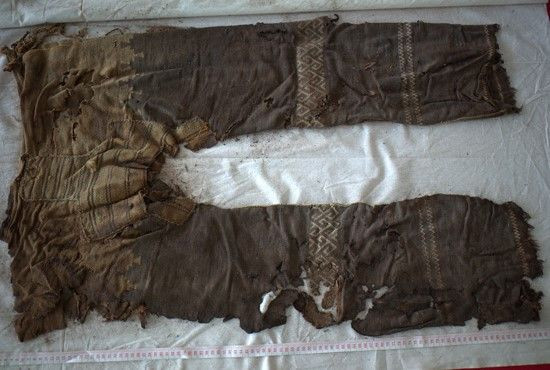World’s Oldest Pants Found In 3,000-Year-Old Chinese Grave Reveal Possible Origin Of Trousers

Two pairs of timeworn pants recently recovered from an ancient gravesite in China give new meaning to vintage fashion.
The woolen pants date back to between the 13th and 10th centuries B.C. and appear to be the earliest examples of trousers ever found. Researchers say the garments point to a possible origin for pants wearing that coincides with the advent of horseback riding, something many experts have long speculated to be the case.
"During normal movements the inner parts of the legs, the crotch and the lower abdomen are not exposed to friction over an extended period of time," Mayke Wagner, a researcher from the German Archaeological Institute in Berlin and leader of the team that discovered the ancient slacks, told New Scientist. "This only becomes an issue when straddling a horse daily."
Wagner and her team were working in an ancient graveyard in Xinjiang, now northwest China, known as the Yanghai tombs when they discovered two middle-aged adult males, believed to be herders and warriors, buried in two of the gravesites and still wearing their pants.
The Yanghai tombs are part of a large burial ground that dates back thousands of years and is attributed to the ancient Gushi culture. Archaeologists have excavated roughly 500 gravesites at Yanghai thus far.
A detailed study of the pants was published May 22 in the journal Quaternary International. According to the report, each pair of pants was made from three independently woven pieces of fabric using a loom and was custom-made to fit its wearer. The yarn used to make the fabric as well as the threads for final sewing were of the same color and quality, suggesting that the weaver and the tailor were one in the same.
Even more, the pants have straight-fitting legs and low-hanging crotches, which mean the modern-day drop-crotch trend could have roots in ancient China (sorry, Justin Bieber.)
Scientists used radiocarbon dating to determine the age of the trousers.
In addition to the two pairs of pants, researchers uncovered several artifacts that suggest the men who wore them were horse riders. The objects included a horse bit made of wood, a whip, a bow and a battle-axe.
Researchers say the pants would have been comfortable for long periods of horseback riding. The wide crotch would make straddling a horse easier by protecting the groin from irritation.
In ancient China, switching from robes to pants became a matter of life and death. Facing invasion by nomadic horsemen from Central Asia, Chinese soldiers were forced to ditch their robes for more form-fitting legwear, according to University of Connecticut evolutionary biologist Peter Turchin notes.
Other examples of early pants wearing were seen in ancient Japan and North America.
© Copyright IBTimes 2024. All rights reserved.






















